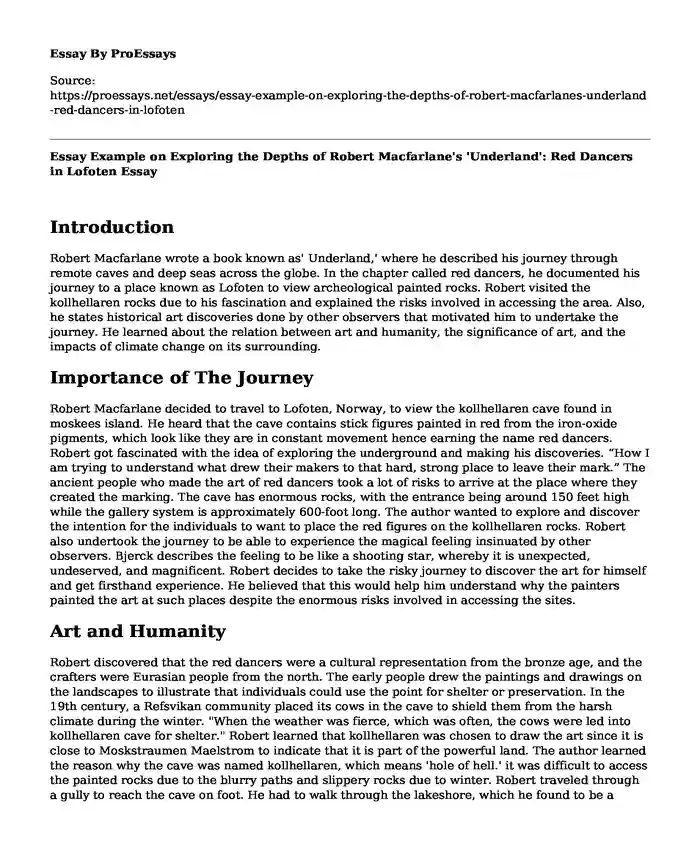Introduction
Robert Macfarlane wrote a book known as' Underland,' where he described his journey through remote caves and deep seas across the globe. In the chapter called red dancers, he documented his journey to a place known as Lofoten to view archeological painted rocks. Robert visited the kollhellaren rocks due to his fascination and explained the risks involved in accessing the area. Also, he states historical art discoveries done by other observers that motivated him to undertake the journey. He learned about the relation between art and humanity, the significance of art, and the impacts of climate change on its surrounding.
Importance of The Journey
Robert Macfarlane decided to travel to Lofoten, Norway, to view the kollhellaren cave found in moskees island. He heard that the cave contains stick figures painted in red from the iron-oxide pigments, which look like they are in constant movement hence earning the name red dancers. Robert got fascinated with the idea of exploring the underground and making his discoveries. “How I am trying to understand what drew their makers to that hard, strong place to leave their mark.” The ancient people who made the art of red dancers took a lot of risks to arrive at the place where they created the marking. The cave has enormous rocks, with the entrance being around 150 feet high while the gallery system is approximately 600-foot long. The author wanted to explore and discover the intention for the individuals to want to place the red figures on the kollhellaren rocks. Robert also undertook the journey to be able to experience the magical feeling insinuated by other observers. Bjerck describes the feeling to be like a shooting star, whereby it is unexpected, undeserved, and magnificent. Robert decides to take the risky journey to discover the art for himself and get firsthand experience. He believed that this would help him understand why the painters painted the art at such places despite the enormous risks involved in accessing the sites.
Art and Humanity
Robert discovered that the red dancers were a cultural representation from the bronze age, and the crafters were Eurasian people from the north. The early people drew the paintings and drawings on the landscapes to illustrate that individuals could use the point for shelter or preservation. In the 19th century, a Refsvikan community placed its cows in the cave to shield them from the harsh climate during the winter. "When the weather was fierce, which was often, the cows were led into kollhellaren cave for shelter." Robert learned that kollhellaren was chosen to draw the art since it is close to Moskstraumen Maelstrom to indicate that it is part of the powerful land. The author learned the reason why the cave was named kollhellaren, which means 'hole of hell.' it was difficult to access the painted rocks due to the blurry paths and slippery rocks due to winter. Robert traveled through a gully to reach the cave on foot. He had to walk through the lakeshore, which he found to be a terrifying experience.
Art creates a connection between people of different times, making time seem to be an illusion due to the feeling experienced when exposed to art. "Suddenly, unexpectedly, my head begins to tingle and then my back and my chest start to shake, and I find myself crying, sobs shuddering my body in the teardrop-shaped rift, far from another human and so close to these generous figures," Robert explains the feeling he experienced from discovering the red dancers. The art is created at places where the painters and observers faced considerable risks to access the area, indicating a special connection between art and humanity.
Robert also received aid from several people to be able to locate and access the arts. He was informed about the red dancers by the first explorer who shared his experience that motivated him to set up the journey to seek the arts in the cave. He also received transportation, accommodation, and food from Hein and Roy en route to the caves. This implicates that art tends to promote humanity among people.
Climate Change
In the story by Robert, it highlighted how climate change alters the habitation of human life. Adverse changes to the climate make it difficult for humans to live in such places. "There is nothing over there on the west side. No houses, no people, no cell-phone signal. Just the cliffs
and the sea. And snow, "Robert is informed of this by Roy, the retired fisherman he stays with before embarking on the journey to find the cave. The changes in climate can be natural or artificial. Robert states the art is unavailable at various places since they were buried under the glaciers during the ice age.
The book noted ethical issues concerning climate change, such as pollution. During Robert’s travel through the Norway beaches, he saw pollutants such as plastic bottles, nylon, and crate pieces disposed on the remote coast. It indicated that people still disposed of waste in a sensitive natural environment, which is a significant danger to the eco-system. This is one of the various ways of how climate change may be induced artificially.
Cite this page
Essay Example on Exploring the Depths of Robert Macfarlane's 'Underland': Red Dancers in Lofoten. (2023, Sep 11). Retrieved from https://proessays.net/essays/essay-example-on-exploring-the-depths-of-robert-macfarlanes-underland-red-dancers-in-lofoten
If you are the original author of this essay and no longer wish to have it published on the ProEssays website, please click below to request its removal:
- Global Warming Experiment Paper Example
- The Universality of Metamorphosis by Franz Kafka Essay Example
- Fashion and Identity Essay
- Creative Writing on Alternate Ending of The Great Gatsby
- Essay Example on Immigrants' Struggle With a Different Culture: Padel and Nagra's Poems
- Essay Sample on Ice Storm 1998: Unprecedented Impact & Meteorological Evolution
- Essay Sample on Ranking Movies & TV Shows: A New Business Opportunity







